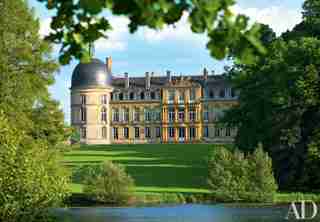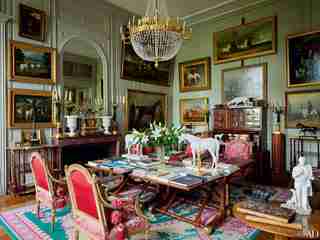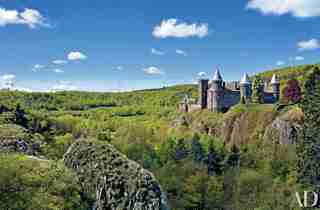13 of the Most Elaborate French Châteaux Ever Featured in AD
French châteaux are some of the world’s most awe-inspiring examples of extravagant design. These historically significant residences, many of which once belonged to lords or nobles, often boast ornate architecture and acres of elaborate gardens, as well as palatial interiors that include exquisite decorative details and priceless antiques . We’ve pored through the AD archives to find some of the most enchanting French châteaux that have appeared in our pages. From the Grand Salon of interior designer Timothy Corrigan’s sensitively remodeled Château du Grand-Lucé in Loire Valley to the hand-carved furnishings of the Château du Sailhant in Auvergne, these regal residences exude majesty and elegance.

The early-1700s north façade of Château de Digoine—the restored Burgundy home of French collector and television producer Jean-Louis Remilleux—is framed by an English-style landscape.

On one side of the double salon in Château de Digoine , mahogany tables used by Napoléon during his Elba exile stand on a carpet from Carlos de Beistegui’s Château de Groussay, which Remilleux once owned; the equestrian paintings include works by John Wooton, Eugène Delacroix, and Carle Vernet.

In the volcanic Auvergne region of central France, Château du Sailhant looms over 100-foot perpendicular cliffs. Architect Joseph Pell Lombardi, a preservation specialist for the past 40 years, restored the 12,500-square-foot château fort, which had not been modified for 100 years and whose earliest construction dates to the tenth century.
“The library is furnished with a complete set of hand-carved furniture in the French neo-Gothic style,” says Lombardi, who researched every phase of Château du Sailhant’s history, inside and out. This suite was carved by a local craftsman from the oak beams of Reims cathedral after the church was bombed during World War I.
Château du Grand-Lucé , which is Los Angeles–based interior designer Timothy Corrigan’s residence in the Loire Valley of France, was built as a summer palace in the 1760s. It features 26 acres of formal gardens.
The Grand Salon of Château du Grand-Lucé overlooks the home’s gardens, which were restored by the French government and are open to the public six times a year; fluted pilasters frame the doors and windows, and the George Smith armchairs are upholstered in a Schumacher linen.
Designer Timothy Corrigan renovated Château de Gallerande , a 15th-century estate in the Loire Valley that featured a 12th-century octagonal tower.
Designer Anthony Ingrao was commissioned to turn a medieval priory in France’s Lubéron region into a personal retreat. In the structure’s entrance courtyard, centuries of development were peeled back.
Corridor Pin, Blue , 1999, one of the famous collaborative sculptures by Coosje van Bruggen and her husband, Claes Oldenburg, stands on the grounds of their Loire Valley château. The various structures on the verdant estate date from the 16th, 17th and 18th centuries.
In the medieval hill town of Ménerbes, France, a fortified château dating from the 11th century was sensitively renovated at the hands of an American couple. Here, a balustrade encloses the principal building, constructed in the 17th century.
The 16th-century Château de Fontenay was redecorated for a British entrepreneur by Tino Zervudachi. The moated estate is located in an architectural region called La Beauce, just 70 miles from Paris.
A lit à la polonaise is the focal point of one bedroom at Château de Fontenay.
Hand-painted chinoiserie murals by Jean Pillement adorn the curved walls of the tower room in the Château de Haroué. The grand space in the 18th-century château, which was built in the Lorraine region by Germain Boffrand, “is the single room that represents all that is glorious about French design,” says decorator Timothy Corrigan.
The late garden designer, style icon, and philanthropist Bunny Mellon collaborated with French couturier Hubert de Givenchy on an ultramodern boxwood parterre at Château du Jonchet, his country estate in Normandy.
A William Kent–style bench holds a basket of flowers from the garden in the entrance hall of fashion designer Peter Copping’s château in Normandy .
Château du Fresne , the neoclassical country house of decorative-arts dealer Flore de Brantes near Tours, was completed by architect Anatole Amoudru in 1770. At left is the pavilion where Brantes and her family live.
François Boucher tapestries lend a fête champêtre touch to the gilded grand salon; the Empire chairs are signed "Jacob."
Château de Wideville , the 17th-century French estate of Valentino Garavani, was built outside Paris by Louis XIII's finance minister and later became home to one of Louis XIV's mistresses.
English chinoiserie mirrors from the 1880s flank the marquetry doors in the winter garden; the Dutch center table incorporates delftware accents.